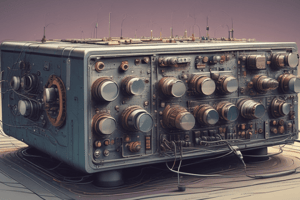Podcast
Questions and Answers
In digital electronics, what is the primary difference between an ideal pulse and a nonideal pulse?
In digital electronics, what is the primary difference between an ideal pulse and a nonideal pulse?
- An ideal pulse is susceptible to noise, while a nonideal pulse is immune to noise.
- An ideal pulse has instantaneous transitions between states, while a nonideal pulse has gradual transitions. (correct)
- An ideal pulse has a gradual transition between states, while a nonideal pulse has instantaneous transitions.
- An ideal pulse has a lower voltage level than a nonideal pulse.
Which characteristic of a digital pulse is LEAST relevant when considering it in an idealized digital circuit analysis?
Which characteristic of a digital pulse is LEAST relevant when considering it in an idealized digital circuit analysis?
- Pulse amplitude (correct)
- Pulse fall time
- Pulse duration
- Pulse rise time
Why is it important to study nonideal pulse characteristics despite the simplification offered by ideal pulse representations in digital circuit design?
Why is it important to study nonideal pulse characteristics despite the simplification offered by ideal pulse representations in digital circuit design?
- Nonideal characteristics directly translate to errors in digital signal processing.
- Nonideal characteristics, such as rise time, affect the maximum operating frequency and signal integrity of digital circuits. (correct)
- Nonideal characteristics are only relevant in analog circuits, not digital circuits.
- Nonideal characteristics allow for simpler mathematical modeling of digital circuits.
In a digital system, if a pulse's rise time is significantly longer than its ideal duration, what potential problem could arise?
In a digital system, if a pulse's rise time is significantly longer than its ideal duration, what potential problem could arise?
A digital circuit designer is deciding between two logic gates for a high-speed application. Gate A has faster switching speed, but Gate B has better noise immunity. Which should the designer prioritize and why?
A digital circuit designer is deciding between two logic gates for a high-speed application. Gate A has faster switching speed, but Gate B has better noise immunity. Which should the designer prioritize and why?
Flashcards
Ideal Pulse
Ideal Pulse
A pulse signal with perfect rise and fall times and no distortion.
Nonideal Pulse
Nonideal Pulse
A pulse signal characterized by rise/fall time imperfections and potential distortion.
Pulse Signal
Pulse Signal
An electrical signal that alternates between high and low states over time.
Rise Time
Rise Time
Signup and view all the flashcards
Fall Time
Fall Time
Signup and view all the flashcards
Study Notes
Digital and Analog Quantities
- Analog quantities are continuous, having a range of values.
- Digital quantities are discrete, having a set of specific values.
Introductory Concepts
- Analog quantities can be represented by continuous waveforms (e.g., temperature over time).
- Digital quantities can be represented by a series of 1s and 0s.
- Analog signals can be digitized by sampling and quantizing.
Binary Digits, Logic Levels, and Digital Waveforms
- Digital systems use two states: HIGH (1) and LOW (0).
- These states are represented by different voltage levels.
- In positive logic, HIGH corresponds to a higher voltage and LOW to a lower voltage.
Logic Levels
- Specific voltage ranges define HIGH and LOW levels in circuits (e.g., CMOS circuits).
- Values between the HIGH and LOW voltage ranges are unacceptable.
Digital Waveforms
- Digital waveforms consist of HIGH and LOW pulses.
- Pulses have rise and fall times.
- Pulse width is a crucial parameter.
- Nonideal pulses include overshoot, ringing, and droop.
Waveform Characteristics
- Periodic waveforms repeat at fixed intervals (period).
- Frequency (f) is the reciprocal of the period (f = 1/T).
- Duty cycle is the percentage of time a pulse is HIGH during a period.
Example 1-1
- Calculate period, frequency, and duty cycle from waveform.
Example 1-2
- Calculate serial transfer time of bits.
- Transfer time for parallel transfer of bits is shown.
Studying That Suits You
Use AI to generate personalized quizzes and flashcards to suit your learning preferences.




